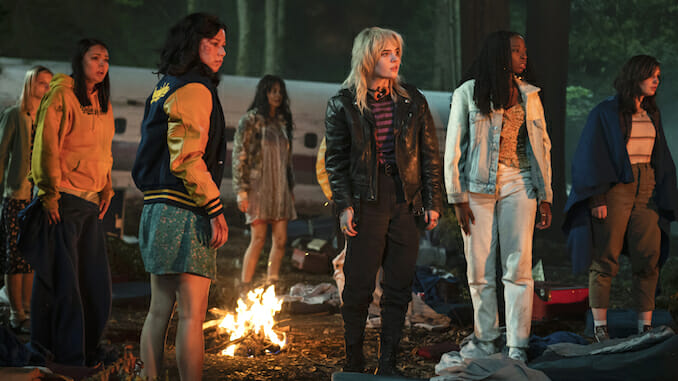Yellowjackets: Showtime’s Series Skillfully Stirs in Sports, Suburbs, Survival, and the Supernatural
Photo Courtesy of Showtime
American pop culture is thoroughly saturated with stories that remind us teen boys are basically animals, forever existing moments away from becoming vicious, possibly murderous monsters. (Thanks, Lord of the Flies!) But rarely are we given the opportunity to explore the darker sides of teen girls in the same way. Sure, plenty of stories have gleefully depicted the complex hierarchies of young women and the cruelties they often visit upon one another in an emotional or social context (Heathers, Jawbreaker, Mean Girls). But while those properties often can and do contain violence, there’s generally a sense that those girls are somehow the victims of larger forces than themselves—the patriarchy, the general misogynistic expectations of society. So far, so familiar.
Young women, after all, couldn’t possibly be as brutish, aggressive, and violent as young men are. It’s just not in their nature, right? Or, at least, that’s basically what Flies author William Golding himself once essentially argued when asked why his famous story didn’t have any female characters in it. “Women are foolish to pretend they are equal to men,” he said. “They are far superior and always have been. But one thing you can’t do with them is take a bunch of them and boil them down, so to speak, into a set of little girls who would then become a kind of image of civilization, of society.”
This is probably a big part of the reason that Showtime’s new survival thriller Yellowjackets feels like such a breath of fresh air. The series is an intriguing mix of genres: part 1990s-set horror story and part modern-day mystery, with heaping doses of teenage angst and supernatural weirdness thrown on top. It honestly feels like nothing else on television right now, and though its pace is somewhat more glacial than its trailers might have initially indicated, there are moments where the tension—combined with our knowledge that many of these people aren’t going to make it out of this alive—is nigh unbearable.
The story begins in 1996 and follows the titular Yellowjackets, a New Jersey girls high school soccer team on their way to nationals. But when the private plane lent by a rich dad for the trip goes down in the Colorado mountains, they spend the next 19 months fighting to stay alive—a feat not all of them apparently accomplish. We know this because the other half of the show’s plot is set 25 years later, as several of the crash survivors find themselves visited by a nosy reporter aiming to write a book about their stories.
There’s Natalie (Juliette Lewis), a gun-toting addict who’s in and out of rehab; Misty (Christina Ricci, in the most perfect role she’s had in years), a gloriously officious and decidedly creepy nurse who spends her free time digging into cold cases with an online “citizens detective” internet group, and still remembers an insane amount of detail about everyone she went to high school with; Shauna (Melanie Lynskey), who got married young—to the man who used to be her best friend and former teammate’s boyfriend—and who now lives in the suburbs with a surly teen daughter of her own and a husband who’s always “working late;” and Taissa (Tawny Cypress), a married lesbian with a young son, whose campaign for public office is putting all the former Yellowjackets in an uncomfortable position and threatening the assorted secrets they’ve promised to keep.
The strength of Yellowjackets lies not just in its great cast (the group of young actresses playing the stranded soccer team is excellent across the board, and I’m honestly furious that Lewis and Ricci haven’t teamed up for something before this), but in its confident grasp of itself and the story that it’s telling—even when it’s not necessarily clear to viewers where it’s all going.
The flashback scenes are drenched in alt-rock nostalgia, complete with PJ Harvey needle drops and a sly self-awareness about the fact that several of Yellowjackets’ stars were once 1990s it-girls themselves. The survival timeline feels like a horror film, with a constantly escalating sense of dread as the girls run out of supplies and struggle to find food while several of their numbers begin to wonder whether there are darker forces at work around them.
-

-

-

-

-

-

-

-

-

-

-

-

-

-

-

-

-

-

-

-

-

-

-

-

-

-

-

-

-

-

-

-

-

-

-

-

-

-

-

-








































